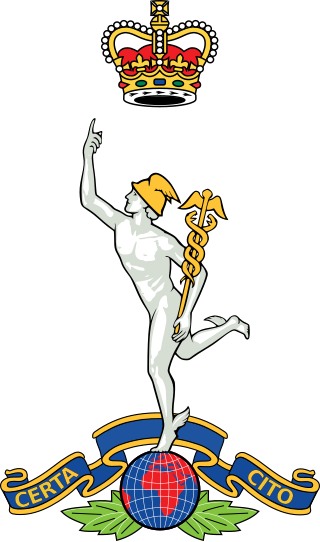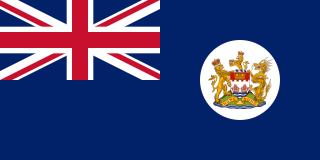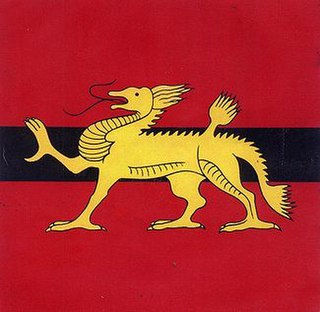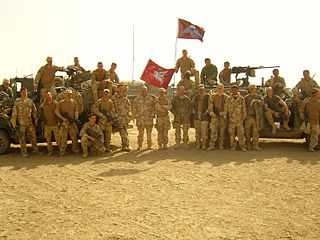
Brigade of Gurkhas is the collective name which refers to all the units in the British Army that are composed of Nepalese Gurkha soldiers. The brigade draws its heritage from Gurkha units that originally served in the British Indian Army prior to Indian independence, and prior to that served for the East India Company. The brigade includes infantry, engineering, signal, logistic and training and support units. They are known for their khukuri, a distinctive heavy knife with a curved blade, and have a reputation for being fierce and brave soldiers.

The Royal Corps of Signals is one of the combat support arms of the British Army. Signals units are among the first into action, providing the battlefield communications and information systems essential to all operations. Royal Signals units provide the full telecommunications infrastructure for the Army wherever they operate in the world. The Corps has its own engineers, logistics experts and systems operators to run radio and area networks in the field. It is responsible for installing, maintaining and operating all types of telecommunications equipment and information systems, providing command support to commanders and their headquarters, and conducting electronic warfare against enemy communications.

The Royal Gurkha Rifles (RGR) is a rifle regiment of the British Army, forming part of the Brigade of Gurkhas. Unlike other regiments in the British Army, RGR soldiers are recruited from Nepal, which is neither a dependent territory of the United Kingdom nor a member of the Commonwealth.

The Adjutant General's Corps is a corps in the British Army responsible for many of its general administrative services, named for the Adjutant-General to the Forces. As of 2002, the AGC had a staff of 7,000 people.

British Forces Overseas Hong Kong comprised the elements of the British Army, Royal Navy and Royal Air Force stationed in British Hong Kong. The Governor of Hong Kong also assumed the position of the commander-in-chief of the forces and the Commander British Forces in Hong Kong took charge of the daily deployment of the troops. Much of the British military left prior to the handover of Hong Kong to China in 1997. The present article focuses mainly on the British garrison in Hong Kong in the post Second World War era. For more information concerning the British garrison during the Second World War and earlier, see the Battle of Hong Kong.

The People's Liberation Army Hong Kong Garrison is a garrison of the People's Liberation Army (PLA), responsible for defence duties in the Hong Kong Special Administrative Region (SAR) since the sovereignty of Hong Kong was transferred to China in 1997. Prior to the handover of Hong Kong, the territory was under British rule, and the defence of the territory was the responsibility of the British Forces Overseas Hong Kong, with auxiliary help from the Royal Hong Kong Regiment.

The 7th Gurkha Rifles was a rifle regiment of the British Indian Army, before being transferred to the British Army, following India's independence in 1947 and after 1959 designated as the 7th Duke of Edinburgh's Own Gurkha Rifles.

The Hong Kong Military Service Corps (HKMSC) was a British army unit and part of the British garrison in Hong Kong. Throughout the history of Hong Kong, it has been the only regular British army unit raised in the territory made up almost entirely of Locally Enlisted Personnel (LEP).

The Royal Hong Kong Regiment (The Volunteers) (RHKR(V)) (Chinese: 皇家香港軍團(義勇軍)), formed in May 1854, was a local auxiliary militia force funded and administered by the colonial Government of Hong Kong. Its powers and duties were mandated by the Royal Hong Kong Regiment Ordinance.
The British Army primarily divides its infantry into regiments, which are subdivided into battalions. However, for various reasons, since the end of the Second World War it has also maintained companies that are intended to provide increments and reinforcements.

Gun Club Hill Barracks are barracks in King's Park, or in Jordan, Hong Kong formerly used by British Army garrisons during British colonial rule. The military began using the area shortly after 1860 when the British acquired Kowloon. The barracks are bounded by Austin Road, Jordan Path, Gascoigne Road and Chatham Road South.
The Hong Kong Garrison was a British and Commonwealth force that protected Hong Kong. In December 1941 during the Battle of Hong Kong in the Second World War, the Japanese Army attacked Hong Kong and after a brief but violent series of engagements the garrison surrendered. The garrison continued until 1989.

15 Air Assault Support Squadron is a British Army logistic squadron, currently under 13 Air Assault Support Regiment RLC.
No. 660 Squadron AAC is a squadron of the British Army's Army Air Corps (AAC). The squadron traces its lineage to a Royal Air Force squadron that existed during the Second World War. In the late 1950s the squadron's numerical was transferred to the AAC and since its formation in 1969, it has operated as a British Army unit flying various types of battlefield helicopters. The squadron has been re-formed and disbanded on a number of occasions. The squadron is currently based at RAF Shawbury where it forms part of No. 1 Flying Training School, but it has been deployed operationally to Northern Ireland, Hong Kong and Brunei throughout its existence.

The 36 Engineer Regiment is a regiment of the Corps of Royal Engineers within the British Army. The regiment trace their history back to before World War II as 36 Army Engineer Regiment. The regiment today is a general support engineer regiment provided force support within 12 Engineer Group.

The structure of the British Army is being reorganised to the Future Soldier structure. The Army is commanded by the Chief of the General Staff (CGS), with Army Headquarters which is located in Andover, Hampshire. Subordinate to that post, there is a Commander Field Army, and a personnel and UK operations command, Home Command.
The following is a hierarchical outline for the British Armed Forces at the end of the Cold War. It is intended to convey the connections and relationships between units and formations.

2 Signal Regiment is a signal regiment of the Royal Corps of Signals within the British Army.

The GurkhaAllied Rapid Reaction Corps Support Battalion, or simply the GurkhaARRC Support Battalion is a combat support unit of the British Army, and one of only three units permanently assigned to NATO. For administrative purposes, the Gurkha ARRC Support Battalion falls under the oversight of the Royal Logistic Corps, though employs members from many other cap badges.
Future Soldier is a reform of the British Army resulting from the Integrated Review of Security, Defence, Development and Foreign Policy published in March 2021. The aim of the reform is to create a more lethal, agile and expeditionary force, able to fight and win wars and to operate in the grey-zone between peace and war. Future Soldier was published on 25 November 2021 and deals with the organizational changes of the British Army, with changes to personnel and equipment were set out in the Defence in a Competitive Age paper published on 22 March 2021.













